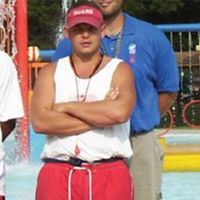Jason E Burdette
age ~43
from Rosharon, TX
- Also known as:
-
- Jason B Burdette
- Jason E Berdette
- Jason Burdett
Jason Burdette Phones & Addresses
- Rosharon, TX
- Pearland, TX
- 1512 N Lasalle St, Indianapolis, IN 46201
- 1337 Carroll White Dr, Indianapolis, IN 46219 • 3176373017
- Columbus, OH
Us Patents
-
Well Modeling Associated With Extraction Of Hydrocarbons From Subsurface Formations
view source -
US Patent:8301425, Oct 30, 2012
-
Filed:Jul 6, 2006
-
Appl. No.:11/922537
-
Inventors:Bruce A. Dale - Sugar Land TX, US
Rahul Pakal - Pearland TX, US
David C. Haeberle - Cypress TX, US
Jason A. Burdette - Houston TX, US
John W. Mohr - Victoria, AU
Darren F. Rosenbaum - Doha, QA
Marcus Asmann - Pearland TX, US
Scott R. Clingman - Houston TX, US
Brian W. Duffy - Houston TX, US
Timothy G. Benish - Pearland TX, US -
Assignee:ExxonMobil Upstream Research Company - Houston TX
-
International Classification:G06G 7/48
-
US Classification:703 10
-
Abstract:A method and apparatus for producing hydrocarbons is described. In the method, a failure mode for a well completion is identified. A numerical engineering model to describe an event that results in the failure mode is constructed. The numerical engineering model is converted into a response surface. Then, the response surface is associated with a user tool configured to provide the response surface for analysis of another well.
-
Method And System For Evaluating Groups Of Threaded Connections
view source -
US Patent:8590641, Nov 26, 2013
-
Filed:Nov 20, 2006
-
Appl. No.:12/086569
-
Inventors:A. S. David Khemakhem - Houston TX, US
Mark W. Biegler - Houston TX, US
David A. Baker - Bellaire TX, US
Jason A. Burdette - Houston TX, US
Bruce A. Dale - Sugar Land TX, US
John W. Mohr - Victoria, AU
Ismail Ceyhan - Houston TX, US
James Powers - Houston TX, US
James H. Myers - Katy TX, US
Marcus Asmann - Pearland TX, US -
Assignee:ExxonMobil Upstream Research Company - Houston TX
-
International Classification:E21B 17/02
B23Q 17/20 -
US Classification:175320, 2940702
-
Abstract:A method associated with the selection of tubulars for hydrocarbon production is described. In particular, the method is associated with the evaluation of performance limits of threaded connections. In this method, constituents of an evaluation group of threaded connections are determined via model analysis. Then, physical testing on a first group of threaded connections in the evaluation group is conducted. Modeling analysis on the first group and a second group of threaded connections is performed, wherein the second group are not physically tested. Once modeled, the results from the physical testing and the modeling analysis are compared to assess a characteristic performance factor for the first group. Then, the characteristic performance factor is applied to the second group, and the performance limits are defined based on this characteristic performance factor.
-
Well Modeling Associated With Extraction Of Hydrocarbons From Subsurface Formations
view source -
US Patent:20090205819, Aug 20, 2009
-
Filed:Jul 6, 2006
-
Appl. No.:11/922538
-
Inventors:Bruce A. Dale - Sugar Land TX, US
Rahul Pakal - Pearland TX, US
Jason A. Burdette - Houston TX, US
David C. Haeberle - Cypress TX, US
Scott R. Clingman - Houston TX, US -
International Classification:E21B 47/00
E21B 43/00
E21B 43/16
E21B 43/25
E21B 49/00
G06G 7/48 -
US Classification:16625001, 166369, 1663051, 166 53, 703 10
-
Abstract:A method and apparatus associated with various phases of a well completion. In one embodiment, a method is described that includes identifying failure modes for a well completion. At least one technical limit associated with each of the failure modes is obtained. Then, an objective function for the well completion is formulated. Then, the objective function is solved to create a well performance limit.
-
Modeling Of Hydrocarbon Reservoirs Using Design Of Experiments Methods
view source -
US Patent:20110011595, Jan 20, 2011
-
Filed:Mar 3, 2009
-
Appl. No.:12/920948
-
Inventors:Hao Huang - Houston TX, US
Sheng-Yuan Hsu - Sugar Land TX, US
Jason A. Burdette - Houston TX, US
Marcus Asmann - Pearland TX, US -
International Classification:E21B 43/00
G06G 7/48
G06G 7/57 -
US Classification:166369, 703 6, 703 10
-
Abstract:Methods for generating a surrogate model for subsurface analysis may include identifying input parameters for the subsurface analysis, and selecting a range of values for the identified parameters. The methods also include selecting a design of experiments method for filling sampling points within the ranges of values for the identified input parameters. The design of experiments method may be a classical method or a space-filling technique. The methods also include filling sampling points within the ranges of values for the identified input parameters. The sampling points are filled based on the design of experiments method selected. The methods further include acquiring output values for each of the selected sampling points, and constructing a surrogate model based upon the output values for at least some of the selected sampling points. The surrogate model is a mathematical equation that represents a simplified model for predicting solutions to complex reservoir engineering problems.
-
Methods For Regulating Flow In Multi-Zone Intervals
view source -
US Patent:20110067871, Mar 24, 2011
-
Filed:Mar 5, 2009
-
Appl. No.:12/933018
-
Inventors:Jason A. Burdette - Houston TX, US
Dieter Postl - Manvel TX, US
Bruce A. Dale - Sugar Land TX, US
Federico A. Tavarez - Pearland TX, US
Ted A. Long - Sugar Land TX, US -
International Classification:E21B 43/11
G06G 7/48 -
US Classification:166298, 703 10
-
Abstract:Methods of regulating flow in a hydrocarbon well include identifying at least two dissimilar zones in an interval of a well, perforating a well completion in the interval according to a limited-entry perforation strategy, and re-perforating the well completion in the interval according to a re-perforating strategy. The limited-entry perforation strategy is adapted to produce a plurality of limited-entry perforations. The limited-entry perforation strategy varies the perforations within the interval based at least in part on dissimilarities between the at least two dissimilar zones. The re-perforation strategy produces a plurality of re-perforations and is based at least in part on the limited-entry perforation strategy. The re-perforation strategy is adapted to at least substantially align a portion of the re-perforations with a portion of the limited-entry perforations.
-
Methods And Systems For Determining Near-Wellbore Characteristics And Reservoir Properties
view source -
US Patent:20110087471, Apr 14, 2011
-
Filed:Nov 3, 2008
-
Appl. No.:12/742496
-
Inventors:Dieter Postl - Manvel TX, US
Jason A. Burdette - Houston TX, US
Jim H. Lee - Houston TX, US
Timothy G. Benish - Pearland TX, US
Bruce A. Dale - Sugar Land TX, US -
International Classification:G06F 17/11
G06G 7/48 -
US Classification:703 2, 703 10
-
Abstract:Systems and methods are provided for determining a reservoir property distinct from a near-wellbore/completion characteristic. The methods include obtaining non-transient well data regarding a measurable characteristic of a well that is used to establish a functional relationship between a reservoir property, a near-wellbore/completion characteristic, and the measurable characteristic of the well. A model that relates the reservoir property and the near-wellbore/completion characteristic is used to generate a modeled near-wellbore/completion characteristic value from an input reservoir property value, or vice versa. The input value and the modeled value are then tested against the well data using the functional relationship. The model is used repeatedly with different input values until a validated reservoir property value and a validated near-wellbore/completion characteristic value are identified that at least substantially satisfy the functional relationship. The validated reservoir property value and the validated near-wellbore/completion characteristic are reported for use in business decisions regarding one or more wells.
-
Method And System For Evaluating Groups Of Threaded Connections
view source -
US Patent:20140041864, Feb 13, 2014
-
Filed:Oct 17, 2013
-
Appl. No.:14/056704
-
Inventors:Mark W. Biegler - Houston TX, US
David A. Baker - Bellaire TX, US
Jason A. Burdette - Houston TX, US
Bruce A. Dale - Sugar Land TX, US
John W. Mohr - Missouri City TX, US
Ismail Ceyhan - Houston TX, US
James Powers - Houston TX, US
James H. Myers - Katy TX, US
Marcus Asmann - Pearland TX, US -
International Classification:E21B 19/16
-
US Classification:16625001
-
Abstract:A method associated with the selection of tubulars for hydrocarbon production is described based upon evaluating the performance limits of threaded connections. Constituents of an evaluation group of threaded connections are determined and then a first group of the connections is evaluated via model analysis over a range of conditions. Then, physical testing on a first group of threaded connections in the evaluation group is conducted over that range of conditions. Once modeled, the results from the physical testing and the modeling analysis of the first group are compared to assess a characteristic performance factor for the first group. A second group of threaded connections are determined and the assessed performance factor from the first group is applied to a second group, and the performance limits of the second group are defined over the range of conditions based on this characteristic performance factor, without requiring testing the second group.
Name / Title
Company / Classification
Phones & Addresses
Treasurer , Director
NORTHWOOD HEIGHTS OWNERS ASSOCIATION, INC
Membership Organization
Membership Organization
3409 Northwood St, Houston, TX 77009
Resumes

Chef
view sourceLocation:
9511 Peridot Green Dr, Rosharon, TX 77583
Industry:
Food & Beverages
Work:
Another Broken Egg Cafe Nov 2017 - Oct 2019
Kitchen Manager
Iu Health Nov 2017 - Oct 2019
Chef
Kitchen Manager
Iu Health Nov 2017 - Oct 2019
Chef
Education:
Ivy Tech Community College 2011 - 2013
Associates, Applied Science, Management, Hospitality
Associates, Applied Science, Management, Hospitality
Skills:
Catering
Restaurant Management
Cooking
Food
Food Safety
Hospitality
Restaurant Management
Cooking
Food
Food Safety
Hospitality

Jason Burdette
view source
Jason Burdette
view source
Jason Burdette
view sourceYoutube
Googleplus

Jason Burdette
Work:
Allied Concrete Forming
Relationship:
In_a_relationship

Jason Burdette

Jason Burdette

Jason Burdette

Jason Burdette
Flickr

Jason Burdette
view source
Jason Burdette
view source
Jason Burdette
view source
Jason Burdette
view source
Jason Burdette
view source
Jason Burdette
view source
Jason Burdette
view source
Jason Burdette
view sourceMyspace
Classmates

Jason Burdette
view sourceSchools:
Crescent High School Iva SC 1993-1997
Community:
Gene Hayes, William Mauldin

Jason Burdette
view sourceSchools:
Martin Luther King Middle School Germantown MD 1988-1990
Community:
Eric Ferrell, John Eckstone, Dale Franks

Jason Burdette
view sourceSchools:
Greensboro High School Greensboro GA 1996-2000
Community:
Elizabeth Williams, Ann Mahaffey

Jason Burdette
view sourceSchools:
Claymont High School Uhrichsville OH 1987-1991
Community:
Lawrence Mann, Rich Pica

Jason Burdette
view sourceSchools:
Fremont-Ross High School Fremont OH 1987-1991

Jason Burdette | Herbert ...
view source
Jason Burdette, Crescent ...
view source
Jason Burdette | Hagersto...
view sourceGet Report for Jason E Burdette from Rosharon, TX, age ~43
















